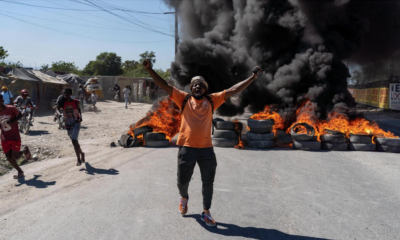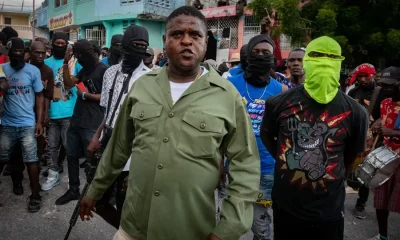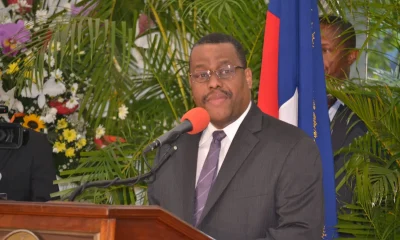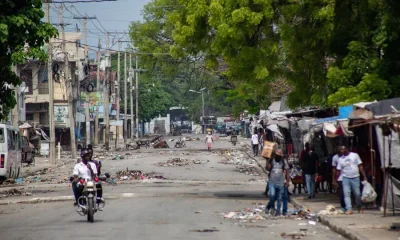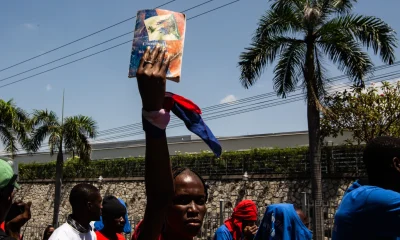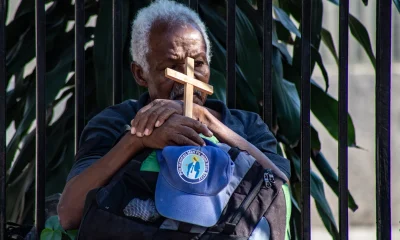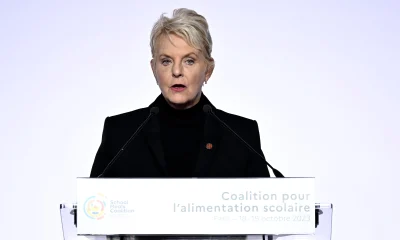International
Tackling hunger in Haiti, the arduous task of the World Food Program
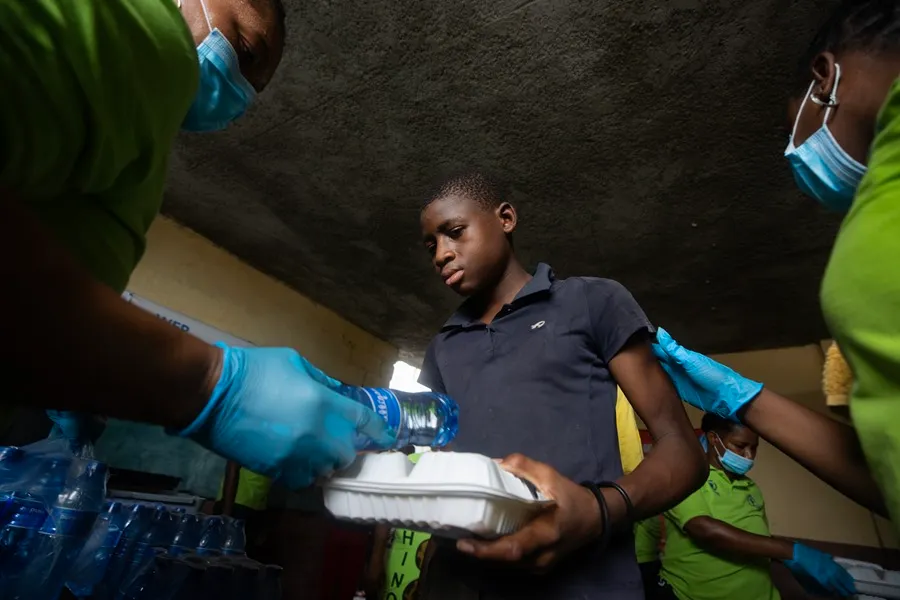
In the Central Kitchen of the World Food Program (WFP) in the capital of Haiti, dozens of people work against the clock to fight hunger: some cut food, others cook in huge pots, some carry trays in vehicles to deliver them to the camps where thousands of families wait for that plate of food, sometimes the only one of the day.
One of those shelters is the Isidor Jean Louis School, in the center of Port-au-Prince, which has been welcoming 600 refugees for months after leaving their homes due to the violence of the armed gangs. There EFE accompanies the WFP.
One of those staying at that hostel is Elva Senfró, 85 years old. He has been there for months after fleeing the neighborhood by his son in the middle of a cruel gang attack.
“The gang was attacking the neighborhood, burning the houses, and my son ran me out of the place and brought me to school, where I have been living for five months (…) I would like to eat something every day, but it is not like that, it is only possible when they bring me something,” this old woman tells EFE.
In Haiti, about five million people (almost half of the population) face acute food insecurity and, of them, 1.64 million face “emergency” levels, according to the data handled by WFP. They are the highest rates since the 2010 earthquake, which caused about 300,000 deaths.
In recent years, Haiti has experienced a steady increase in hunger, and the prevalence of acute food insecurity went from 35% in 2019 to almost 50% in 2024.
Something that the director of the WFP in Haiti, Jean-Martin Bauer, insists on in statements to EFE: “There are five million people who have difficulty getting food. They are people who don’t know what they are going to eat tomorrow, who don’t have money to know if they are going to eat the next day.”
Among the most affected areas is the Artibonite Valley, considered the country’s barn and where armed groups have seized agricultural land and stolen crops.
The department of the West, the rural areas of the south and several poor neighborhoods of the capital, such as Croix des Bouquets and Cité Soleil, with important hotbeds of hunger, are also a cause for concern.
“Artibonite is an area that produced a lot of food for the country and now they themselves have nothing to eat, due to the violence,” explains Bauer, who estimates that there are 3,000 producers who cannot cultivate the land and abandoned it due to the violence of the gangs.
Around two in the afternoon, the staff of the Center for Peasant Animation and Community Action (CAPAC), one of the local organizations with which the WFP works, arrive at the Isidor Jean Louis College.
It is an operation that they carry out daily: some quickly go to school and take the food to a room on the second floor, while others organize the refugees to proceed with the delivery of lunch.
The little ones lead the line, and they are followed by the elderly and pregnant women. They receive a tray of rice with fish and a bottle of water.
The rest of middle-aged people, between pushing and arguments, take a long time to organize to enter the room. When the food is already in his hands, everyone goes to the place of the school where he resides and eats in silence, enjoying every bite.
“The population wants security. People who go to church with the children, who go to school, who go to the market, are afraid and are leaving little because they don’t want to be kidnapped on the street. The population doesn’t deserve that, it deserves a better life,” says Bauer.
And he adds: “Those of us who work on the humanitarian issue would like to see freedom of movement on the street. If there is so much hunger, it’s because the producers can’t get to sell to the capital. We want to see the producers leave the Artibonite and enter the capital to sell their products. That they bring good food to the markets. That is the most important issue for the food system.”
International
Police investigate deaths of Rob Reiner and wife as apparent homicide

The Los Angeles Police Department (LAPD) is investigating the deaths of Hollywood actor and filmmaker Rob Reinerand his wife as an “apparent homicide,” amid a wave of tributes to the director of classics such as When Harry Met Sally.
According to U.S. media reports on Sunday, Rob Reiner and Michele Singer Reiner were found dead at their Los Angeles mansion with what appeared to be stab wounds.
Several political figures shared messages of condolence following the reported deaths of the director of A Few Good Menand his wife.
While the LAPD did not officially confirm the identities of the victims, it stated that homicide detectives were dispatched to the Reiner residence.
“At this time, no additional details are available and the investigation into an apparent homicide is ongoing,” the Los Angeles Police Department said in a statement posted on social media.
LAPD Deputy Chief Alan Hamilton told reporters that no arrests have been made and that no individuals are currently being questioned as suspects.
“I’m not going to confirm whether anyone is being questioned at this moment or not. We are going to try to speak with as many family members as we can,” Hamilton said.
CNN reported that a family spokesperson confirmed the deaths of Reiner and his wife.
California Governor Gavin Newsom, former U.S. President Barack Obama, and former Vice President Kamala Harrisissued statements expressing their condolences.
International
U.S. and Mexico Reach Deal to Address Water Deficit Under 1944 Treaty
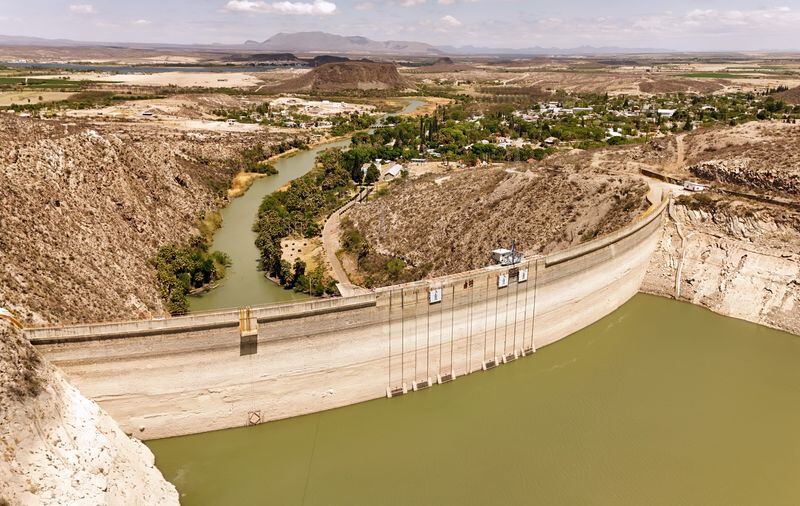
The United States and Mexico have reached an agreement to comply with current water obligations affecting U.S. farmers and ranchers and for Mexico to cover its water deficit to Texas under the 1944 Water Treaty, the U.S. Department of Agriculture said in a statement.
The department уточified that the agreement applies to both the current cycle and the water deficit from the previous cycle.
On Monday, U.S. President Donald Trump accused Mexico of failing to comply with the water-sharing treaty between the two countries, which requires the United States to deliver 1.85 billion cubic meters of water from the Colorado River, while Mexico must supply 432 million cubic meters from the Rio Grande.
Mexico is behind on its commitments. According to Washington, the country has accumulated a deficit of more than one billion cubic meters of water over the past five years.
“This violation is severely harming our beautiful crops and our livestock in Texas,” Trump wrote on Monday.
The Department of Agriculture said on Friday that Mexico had agreed to supply 250 million cubic meters of water starting next week and to work toward closing the shortfall.
Agriculture Secretary Brooke Rollins, quoted in the statement, said Mexico delivered more water in a single year than it had over the previous four years combined.
Trump has said that if Mexico continues to fall short of its obligations, the United States reserves the right to impose 5% tariffs on imported Mexican products.
Mexico’s Deputy Foreign Minister for North America, Roberto Velasco, said that a severe drought in 2022 and 2023prevented the country from meeting its commitments.
International
Several people shot in attack on Brown University campus

Several people were shot on Saturday in an attack on the campus of Brown University, in the northeastern United States, local police reported.
“Shelter in place and avoid the area until further notice,” the Providence Police Department urged in a post on X. Brown University is located in Providence, the capital of the state of Rhode Island.
U.S. President Donald Trump said on his social media platform Truth Social that he had been briefed on the situation and that the FBI was on the scene.
At 5:52 p.m. local time (11:52 p.m. GMT), Brown University said the situation was still “ongoing” and instructed students to remain sheltered until further notice.
After initially stating that the suspect had been taken into custody, Trump later posted a second message clarifying that local police had walked back that information. “The suspect has NOT been apprehended,” the U.S. president said.
-

 Central America2 days ago
Central America2 days agoPanama seizes over three tons of drugs hidden in Caribbean port container
-

 International2 days ago
International2 days agoPolice investigate deaths of Rob Reiner and wife as apparent homicide
-

 International4 days ago
International4 days agoSeveral people shot in attack on Brown University campus
-

 Central America2 days ago
Central America2 days agoOAS urges swift recount in Honduras as election results remain uncertain
-

 Central America19 hours ago
Central America19 hours agoEl Salvador ranks among top countries in the Americas in fight against organized crime
-

 Central America19 hours ago
Central America19 hours agoBukele says AI partnership with xAI will transform public education in El Salvador
-

 International4 days ago
International4 days agoU.S. and Mexico Reach Deal to Address Water Deficit Under 1944 Treaty

























